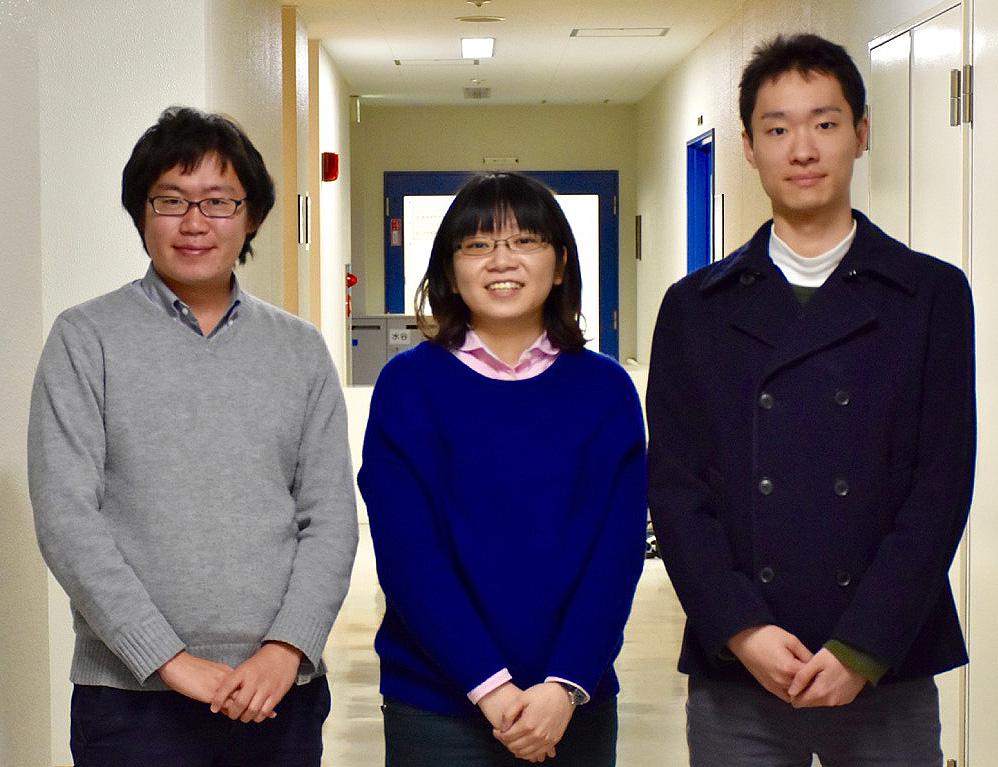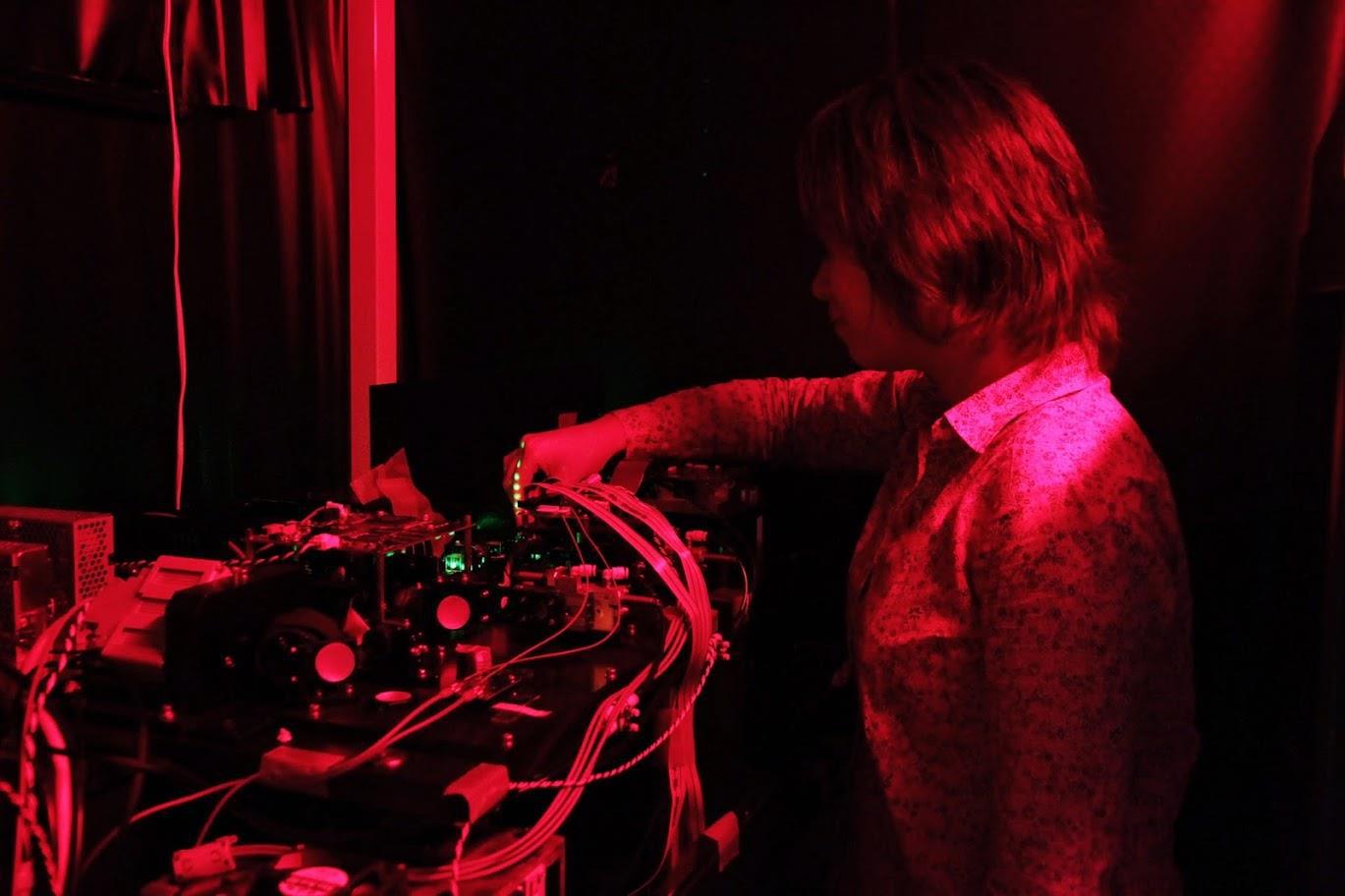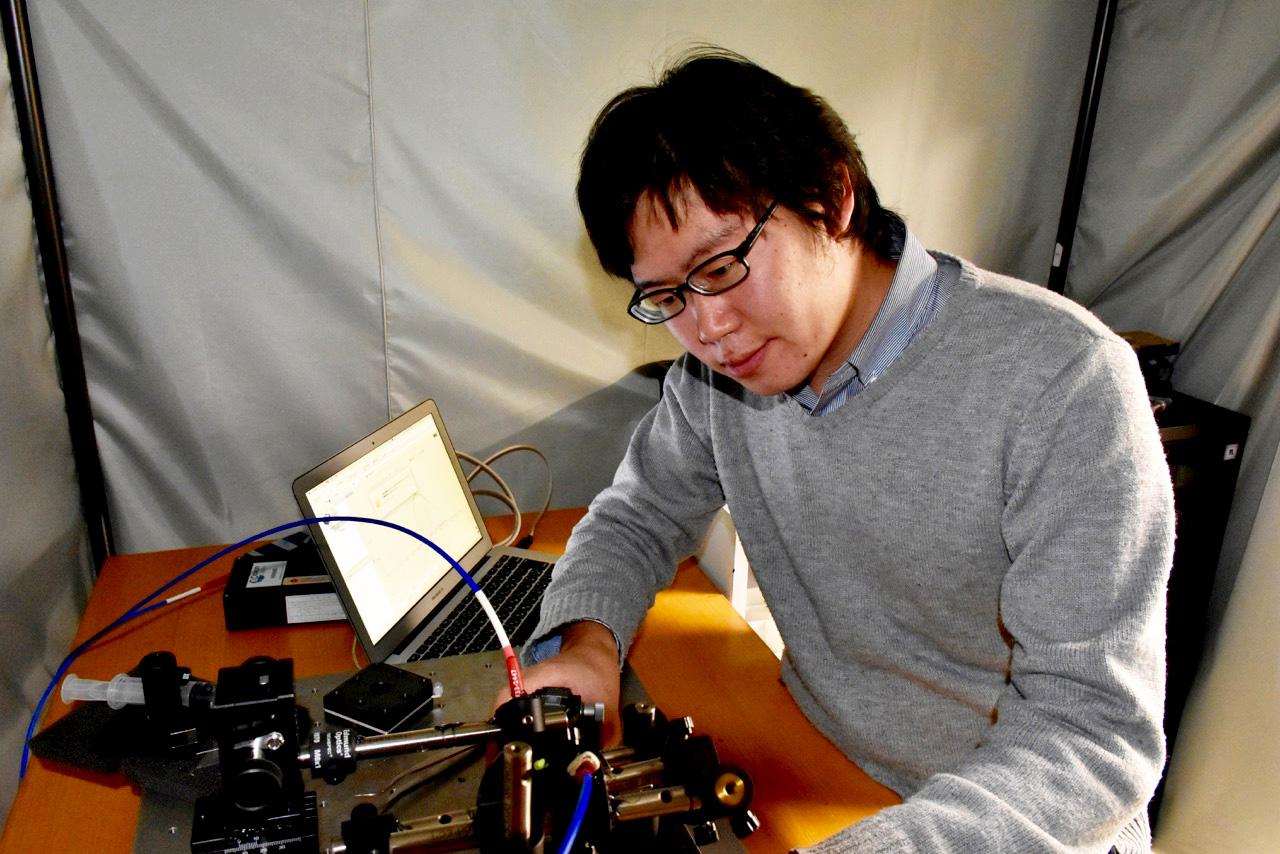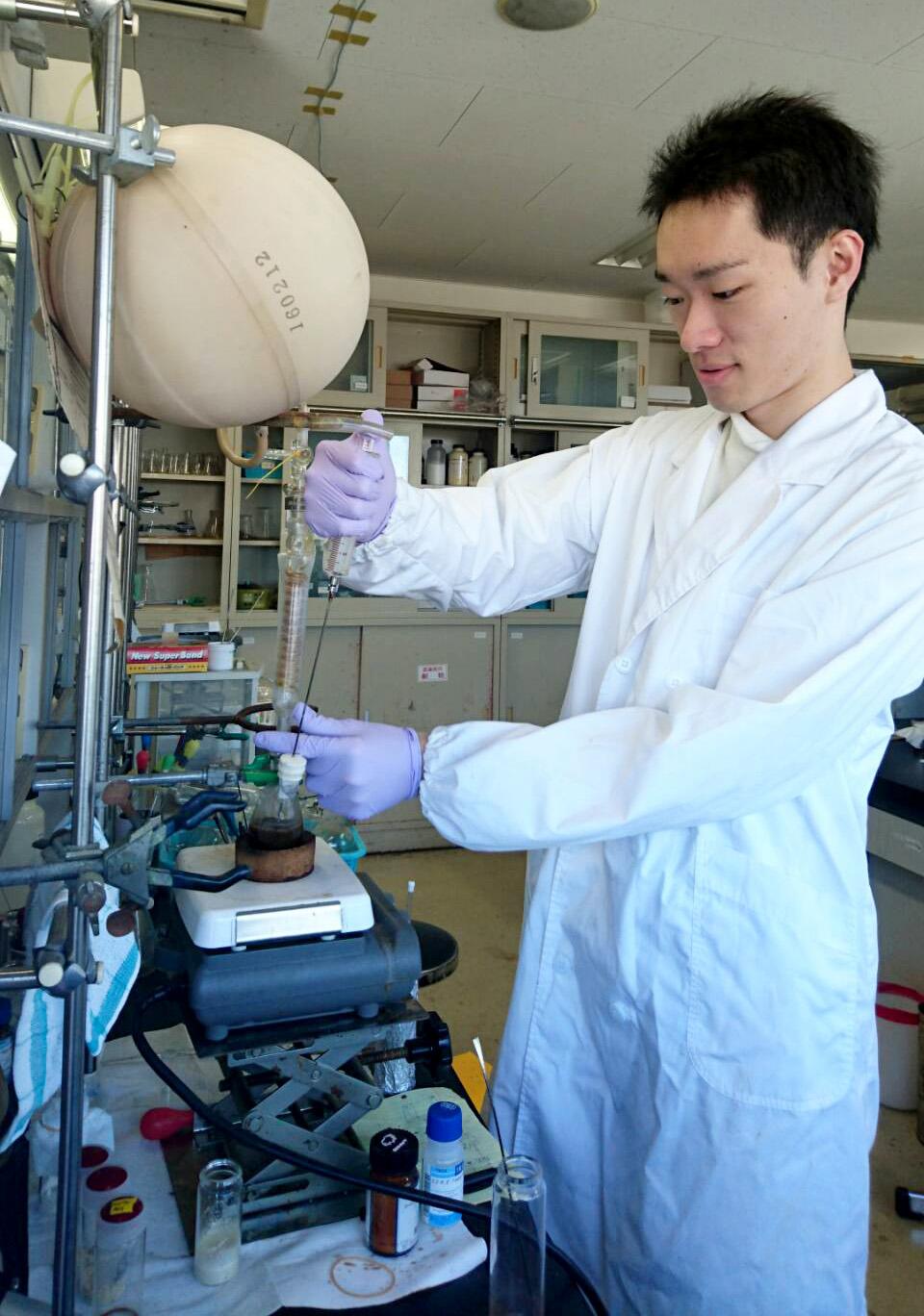December 2016 Issue
Feature
Navigating the open seas of graduate school
The move from undergraduate studies based on highly structured lecture courses with clearly defined goals and timelines to the nerve racking freedom offered by graduate school is a challenging transition. Here, three UEC graduate students describe their goals and share their aspirations in pursuit of scientific excellence.
Time management and freedom
"As an undergraduate I had to take many lecture courses, write reports, attend seminars for credits to complete my course, says Kanami Ikeda. "It was an extremely busy time. I recall having little time to think. But now as a graduate school student there are hardly any compulsory courses, and I have much more time to think about my research. This newly discovered freedom comes with the challenge of the necessity for careful time management to conduct experiments, write papers, and so on."
This view is echoed by Ryoji Yukino, a first year doctoral student. "As a graduate student I think that I am living my own life," says Ryoji. "I am able to make my own decisions about how to proceed with my research. It's much more enjoyable that undergraduate courses and lectures."
Akihiro Ondo shares these views: "I have realized that the research experiments are not like those described in textbooks. In research, the experiments do not always go according to plan. They can yield inexplicable results. It's a different world."
Communication skills
Attending international conferences is an integral part of being a graduate student. Such meetings demand good communication skills from both the speaker's podium and during networking events.
"I was really nervous during my first poster presentation at an international conference," says Ryoji. "One of my main concerns was whether anyone would visit my poster. Thankfully, many people stopped and asked questions. This gave me confidence in describing my research to people I had not ever met before."
Speaking to an audience with a projector and slides can also be demanding. "I remember that I could not reply to questions after finishing my first ever conference presentation," confides Kanami. "My mind suddenly went blank. Following this experience, I focused on improving my presentation skills. The Q&A sessions are fine now."
Plans for the future
UEC graduates are in great demand by Japanese industry reflecting the high-quality of research conducted at the University.And, like all UEC graduates, Kanami, Ryoji, and Akihiro will have many choices after completing their research. "I have not decided what I want to do yet," says Kanami. "Focusing on the applications of my research would be one avenue to follow. Although I am also interested in teaching and academia."

Kanami Ikeda (2nd year doctoral student)
Graduate School of Informatics and Engineering, University of Electro-Communications.
Research
Optical correlation for ultra-high speed data analysis
Key words: Optical correlation, optical disk, holography.
Group and website
Eriko Watanabe Lab
http://thetis.f-lab.tech.uec.ac.jp/
http://www.uec.ac.jp/eng/research/introduction/opal-ring/0005841.html
Summary of a presentation at Irago Conference 2016, (1-2 November 2016, UEC, Chofu, Tokyo).
http://www.iragoconference.jp/
Stabilization of the optical correlation output signal using new methods
The volume of information that is not only generated by people but also generated by, for example, sensors such as those in cameras, has been dramatically increasing. Faster technologies that can analyze the enormous amount of data are required. We have developed an optical correlation system using a coaxial holography system. This optical correlation system has a simple configuration and has a compatibility with a control technique of the conventional optical disk. We improved the disk rotation speed by weight reduction of the objective lens and reduced the shift pitch of the shift multiplex recording for 2μm. We achieved 2.4 Mfps optical correlation experiment that is equivalent to 143 Gbps data transfer speed. We also developed a demonstration system using the optical correlator in a cloud environment.
In this study, for its practical use, we improve the stability of the optical correlation system introducing a new structure disk and a feedback servo system. A simple structure disk without a dichroic layer was designed and fabricated for tracking the servo system although two different color lasers was used. More than 1000 holograms with a 2 μm pitch were written using the high-power green pulse laser and tracking on a single circular groove track. The stable optical correlation signals were obtained from the written holograms using the green CW laser. Therefore, the optical correlation system enable us to demonstrate the image matching for a large number of the database images.

Ryoji Yukino
Graduate School of Informatics and Engineering, University of Electro-Communications.
Research
Magnetic nanoparticle based point of care medical diagnostics
Keywords: Medical diagnostics, magnetic nanoparticles, biosensing, nano-diffraction gratings
Group and website
Adarsh Sandhu Lab
http://www.sandhu.jp/
Summary of a presentation at Irago Conference 2016, (1-2 November 2016, UEC, Chofu, Tokyo).
http://www.iragoconference.jp/
Smartphone-based Platform for Medical Diagnostics
There is increasing demand for point of care medical testing (POCT) in developing countries in the form of simple kits for home use. We are developing POCT protocols based on magnetic nanoparticles, CCD imaging, and smartphones. Here, we describe biomolecule detection by combining a diffraction grating biosensor and smartphone spectroscope.
We used biosensors made of silicon nitride diffraction grating-biosensors fabricated by electron beam lithography. A diffraction grating sensor irradiated with white light only reflects a narrow band of light with a well-defined peak wavelength. The peak wavelength shifts with changes in the refractive index of the surface of the grating. Now, due to the fact that biomolecules have high refractive indices, when they are attached to the sensor, the peak wavelength shifts significantly. Our concept also includes using the CCD camera of a smartphone as a spectroscope to analyze the signal from the diffraction grating sensor. Notably, our system is compact, portable and it is easy to transmit data to centralized health institutes anywhere in the world. In proof of principle experiments, we demonstrated how a diffraction grating sensor can be used to measure the concentration of biomolecules with an avidin-biotin complex. Avidin-biotin interaction was selected because of its well-known bond strength approaching that of a covalent bond with a high affinity constant. Our system clearly detected changes in the concentration of avidin concentration using the smartphone spectrometer.

Akihiro Ondo (1st year master's student)
Graduate School of Informatics and Engineering, University of Electro-Communications.
Research
Development of magnets using organic-organic spin-crossover (SCO) materials.
Key words: Molecule-based magnet, magnetic materials, coordination compounds, organic free radicals.
Group and website
Takayuki Ishida Lab
http://www.uec.ac.jp/eng/research/introduction/opal-ring/0000392.html
Ishida Lab (Japanese)
http://ttf.pc.uec.ac.jp/
Summary of a presentation at Irago Conference 2016, (1-2 November 2016, UEC, Chofu, Tokyo).
http://www.iragoconference.jp/
Structures and Magnetic Properties of Transition-Metal Complexes Involving Bipyridinyl Nitroxide Radicals
Metal-radical hybrid solids have well been investigated toward magnetic materials which show various physical properties on the molecular level. Heteroaromatic substituents (Ar's) are utilized in Ar-NN and Ar-NO, and the Ar groups can ligate transition-metal ions. Exchange coupling is one of the most important parameters in magnetic materials. Magnetic exchange interactions between the radical group and metal ion across the Ar group are larger in Ar-NO than those in Ar-NN, because of larger spin-delocalization on the Ar group. The singly occupied molecular orbital of NN has a node at the central carbon of the NN group, whereas NO is attached to the aromatic ring directly at the spin-carrying N atom. Heteroaromatic-substituted tert-butyl nitroxide radicals were studied. Heteroaromatic rings are known to have a weaker stabilizing effect than phenyl, as indicated by the fact that tert-butyl pyridyl nitroxides are unisolable. Thus, we introduced an additional stabilizing group to a pyridine ring and synthesized and isolated radical ligands containing 2,2'-bipyridine, namely 4bpyNO, 5bpyNO, and 6bpyNO and investigated the structures and magnetic properties of transition-metal complexes involving the above radicals.



